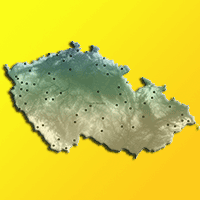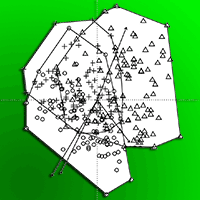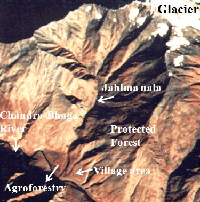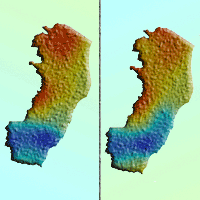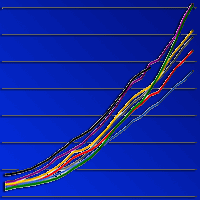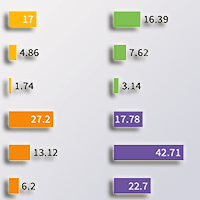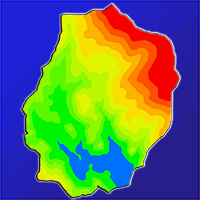
Acid atmospheric deposition in a forested mountain catchment
Josef Krecek (1), Ladislav Palán (1) , Evžen Stuchlík (2)
iForest - Biogeosciences and Forestry, Volume 10, Issue 4, Pages 680-686 (2017)
doi: https://doi.org/10.3832/ifor2319-010
Published: Jul 17, 2017 - Copyright © 2017 SISEF
Research Articles
Abstract
Acid atmospheric deposition is harmful to both forest and aquatic ecosystems. In mountain catchments, acidification also leads to difficulties in water resource management. In 2010-2012, acid atmospheric deposition was analysed in a small forest catchment located in the upper plain of the Jizera Mountains (Czech Republic). Patch observations included monitoring of the canopy interception in two mature stands of Norway spruce (Picea abies) at elevations of 745 and 975 metres a.s.l., and twelve passive fog collectors situated along an elevation gradient between 862 and 994 metres a.s.l. In the studied area, fog (and low cloud) precipitation starts to affect the interception loss of the spruce canopy at elevations above 700 metres. However, fog drip was found to also rise with the canopy area. At the catchment scale, methods of spatial interpolation (ArcGIS 10.2) were used to approximate the aerial atmospheric deposition of water and acidic substances (sulphate, nitrate and ammonia). In the watersheds of two adjacent drinking water reservoirs, Josefuv Dul and Souš, the mean annual fog drip from the canopy was between 88 and 106 mm (i.e., 7-8% of the mean annual gross precipitation, or 10-12% of the mean annual runoff). Simultaneously, this load also deposited 658 kg km-2 of sulphur and 216 kg km-2 of nitrogen (i.e., 55% and 48% of the “open field” bulk amounts). Therefore, in headwater catchments stressed by acidification, the additional precipitation (measured under the canopy) can increase the water yield, but can also contribute to a decline in water quality, particularly in environments of low buffering capacity.
Keywords
Mountain Watershed, Spruce Forests, Acid Atmospheric Deposition, Water Resources Recharge
Authors’ Info
Authors’ address
Ladislav Palán
Department of Hydraulics and Hydrology, Czech Technical University in Prague, Thákurova 7, CZ-166 29 Prague 6 (Czech Republic)
Institute of Hydrobiology, Biology Centre CAS, Na Sádkách 7, CZ-37005 Ceské Budejovice (Czech Republic)
Corresponding author
Paper Info
Citation
Krecek J, Palán L, Stuchlík E (2017). Acid atmospheric deposition in a forested mountain catchment. iForest 10: 680-686. - doi: 10.3832/ifor2319-010
Academic Editor
Elena Paoletti
Paper history
Received: Dec 16, 2016
Accepted: May 08, 2017
First online: Jul 17, 2017
Publication Date: Aug 31, 2017
Publication Time: 2.33 months
Copyright Information
© SISEF - The Italian Society of Silviculture and Forest Ecology 2017
Open Access
This article is distributed under the terms of the Creative Commons Attribution-Non Commercial 4.0 International (https://creativecommons.org/licenses/by-nc/4.0/), which permits unrestricted use, distribution, and reproduction in any medium, provided you give appropriate credit to the original author(s) and the source, provide a link to the Creative Commons license, and indicate if changes were made.
Web Metrics
Breakdown by View Type
Article Usage
Total Article Views: 47772
(from publication date up to now)
Breakdown by View Type
HTML Page Views: 39903
Abstract Page Views: 3032
PDF Downloads: 3812
Citation/Reference Downloads: 19
XML Downloads: 1006
Web Metrics
Days since publication: 3079
Overall contacts: 47772
Avg. contacts per week: 108.61
Citation Metrics
Article Citations
Article citations are based on data periodically collected from the Clarivate Web of Science web site
(last update: Mar 2025)
Total number of cites (since 2017): 14
Average cites per year: 1.56
Publication Metrics
by Dimensions ©
Articles citing this article
List of the papers citing this article based on CrossRef Cited-by.
References
Monitoring wet deposition in forest - quantitative and qualitative aspects. In: “Monitoring Air Pollution and Forest Ecosystem Research: Commission of the European Communities, Air Pollution Reports” (Bresser AHM, Mathy P eds). RIVM, Bilthoven, Netherlands, pp. 39-63.
Gscholar
Atmospheric deposition. International Association of Hydrological Sciences, Wallingford, Oxfordshire, UK, pp. 288.
Gscholar
Forests, air pollution and water quality: influencing health in the headwaters of Central Europe’s “Black Triangle”. Unasylva 224: 46-49.
Gscholar
Fog precipitation and fog drip in forests as an item of water balance in a mountain region. Meteorological Bulletin (Meteorologické zprávy) 32: 78-81. [in Czech]
Gscholar
Methodology to estimate the number of rain gauges under the forest canopy. Journal of Hydrology and Hydromechanics (Vodohospodársky časopis) 479-490. [in Czech]
Gscholar
Influence of meteorological parameters on interception of cloud droplets in a coniferous forest. Beitrage zur Physik der Atmosphere 62: 265-274.
Gscholar
Surface water acidification in the ECE region: regional acidification, current geographical extent of acidification in lakes, streams and reservoirs in the countries of the ECE region. Nordic Council of Ministers, Copenhagen, Denmark, pp. 156.
Online | Gscholar
Seasonal variations and trends of atmosphere-borne nutriet load to the alpine biosphere and pedosphere. In: “The role of the hydrological cycle in Mountain Ecosystems”. University of Zurich, Zurich, Irchel, Switzerland, pp. 17-18.
Gscholar
InStat guide to choosing and interpreting statistical tests. GraphPad Software, Inc., San Diego, California, USA, pp. 154.
Gscholar
Vertical gradients of dissolved chemical constituents in evaporating clouds. Atmospheric Environment 31: 2577-2588.
CrossRef | Gscholar
Assessment methods of fog and low cloud deposition. Meteorological Bulletin (Meteorologické zprávy) 59: 151-157.
Gscholar
Climate atlas of Czechia. Czech Hydrometeorological Institute, Prague, Czech Republic, pp. 256.
Gscholar
Mountain meteorology: fundamentals and applications. University Press, Oxford, UK, pp. 355.
Gscholar
Guidelines for drinking water quality (3rd edn). World Health Organization, Geneva, Switzerland, pp. 515.
Gscholar




